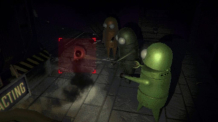Screenshots
Review
R.E.P.O. – A Well-Crafted Cyberpunk Thriller with Tactical Depth
R.E.P.O. is a game that seamlessly blends stealth, strategy, and action, placing players in the role of a highly skilled recovery agent operating in a dystopian cyberpunk world. Developed by AIKODE, the game presents a compelling mix of environmental storytelling, complex mission structures, and an unforgiving difficulty curve that rewards patience and precision. But how well does it hold up under scrutiny? Let’s take a deeper look.
A World of Corporate Control and High-Risk Operations The game’s narrative unfolds in a world dominated by corporate greed, where shadowy organizations hire agents to reclaim lost assets. Rather than relying on lengthy exposition, R.E.P.O. tells its story through environmental details, mission briefings, and fragmented in-game lore. This approach keeps the player immersed without overwhelming them with unnecessary dialogue, though it may leave those seeking a more direct narrative somewhat underwhelmed.
Visually, R.E.P.O. excels in creating a cyberpunk atmosphere. The environments are dark and industrial, illuminated by flickering neon signs and dim emergency lighting. Abandoned research labs, high-security corporate offices, and decayed industrial zones all contribute to an oppressive yet compelling aesthetic. The game’s lighting system is particularly noteworthy, as it plays a crucial role in gameplay, affecting visibility and stealth mechanics.
Gameplay – Strategy Over Brute Force The core of R.E.P.O. lies in its tactical stealth gameplay. Missions are structured around retrieving high-value assets while avoiding—or eliminating—corporate security forces. Each mission presents multiple pathways, allowing for various approaches: players can rely on hacking and sabotage, manipulate the environment to create distractions, or carefully eliminate threats to clear a path forward.
One of the game’s strengths is its AI design. Enemies react dynamically to the player’s actions, adjusting their patrol routes based on suspicious activity. This makes each mission feel tense and unpredictable, as even minor mistakes can trigger heightened security measures. Unlike some stealth games that allow players to easily reset encounters, R.E.P.O. ensures that errors have lasting consequences, forcing strategic adaptation rather than repetition.
Customization and Progression Players are given the ability to upgrade their tools and abilities over time, unlocking new hacking capabilities, stealth enhancements, and advanced tactical gadgets. While the progression system offers meaningful upgrades, it never makes the player overpowered, maintaining a sense of challenge throughout the experience.
However, the game does have a relatively steep learning curve. Early missions provide only minimal guidance, requiring players to experiment and learn through failure. While this can be rewarding for seasoned stealth-game enthusiasts, it may prove frustrating for newcomers. A more robust tutorial system could improve accessibility without diminishing the challenge.
Sound Design and Atmosphere A strong auditory experience complements the visual world-building. The soundscape of R.E.P.O. is carefully crafted, with ambient mechanical hums, distant alarms, and muffled footsteps creating an immersive environment. The game’s soundtrack is understated but effective, utilizing subtle synth-driven tension-building tracks that ramp up dynamically when danger escalates.
Voice acting, though minimal, is well-executed where present. The game also benefits from an impactful use of silence, which enhances the tension when sneaking through heavily guarded areas.
Verdict – A Rewarding but Demanding Experience R.E.P.O. is not a game for those looking for a casual action-adventure. Its emphasis on careful planning, methodical execution, and adaptability makes it a standout entry in the stealth-action genre. While its difficulty may deter some players, those willing to engage with its intricate mechanics will find a deeply rewarding experience. The lack of a more structured narrative might disappoint players looking for a story-driven campaign, but the environmental storytelling and world-building are more than sufficient to create immersion.









0 Comments
Leave a comment
Your comment is awaiting moderation. We save your draft here